Wangkai Li
OCELOT 2023: Cell Detection from Cell-Tissue Interaction Challenge
Sep 11, 2025Abstract:Pathologists routinely alternate between different magnifications when examining Whole-Slide Images, allowing them to evaluate both broad tissue morphology and intricate cellular details to form comprehensive diagnoses. However, existing deep learning-based cell detection models struggle to replicate these behaviors and learn the interdependent semantics between structures at different magnifications. A key barrier in the field is the lack of datasets with multi-scale overlapping cell and tissue annotations. The OCELOT 2023 challenge was initiated to gather insights from the community to validate the hypothesis that understanding cell and tissue (cell-tissue) interactions is crucial for achieving human-level performance, and to accelerate the research in this field. The challenge dataset includes overlapping cell detection and tissue segmentation annotations from six organs, comprising 673 pairs sourced from 306 The Cancer Genome Atlas (TCGA) Whole-Slide Images with hematoxylin and eosin staining, divided into training, validation, and test subsets. Participants presented models that significantly enhanced the understanding of cell-tissue relationships. Top entries achieved up to a 7.99 increase in F1-score on the test set compared to the baseline cell-only model that did not incorporate cell-tissue relationships. This is a substantial improvement in performance over traditional cell-only detection methods, demonstrating the need for incorporating multi-scale semantics into the models. This paper provides a comparative analysis of the methods used by participants, highlighting innovative strategies implemented in the OCELOT 2023 challenge.
* This is the accepted manuscript of an article published in Medical Image Analysis (Elsevier). The final version is available at: https://doi.org/10.1016/j.media.2025.103751
KPIs 2024 Challenge: Advancing Glomerular Segmentation from Patch- to Slide-Level
Feb 11, 2025Abstract:Chronic kidney disease (CKD) is a major global health issue, affecting over 10% of the population and causing significant mortality. While kidney biopsy remains the gold standard for CKD diagnosis and treatment, the lack of comprehensive benchmarks for kidney pathology segmentation hinders progress in the field. To address this, we organized the Kidney Pathology Image Segmentation (KPIs) Challenge, introducing a dataset that incorporates preclinical rodent models of CKD with over 10,000 annotated glomeruli from 60+ Periodic Acid Schiff (PAS)-stained whole slide images. The challenge includes two tasks, patch-level segmentation and whole slide image segmentation and detection, evaluated using the Dice Similarity Coefficient (DSC) and F1-score. By encouraging innovative segmentation methods that adapt to diverse CKD models and tissue conditions, the KPIs Challenge aims to advance kidney pathology analysis, establish new benchmarks, and enable precise, large-scale quantification for disease research and diagnosis.
A Universal Degradation-based Bridging Technique for Domain Adaptive Semantic Segmentation
Dec 13, 2024



Abstract:Semantic segmentation often suffers from significant performance degradation when the trained network is applied to a different domain. To address this issue, unsupervised domain adaptation (UDA) has been extensively studied. Existing methods introduce the domain bridging techniques to mitigate substantial domain gap, which construct intermediate domains to facilitate the gradual transfer of knowledge across different domains. However, these strategies often require dataset-specific designs and may generate unnatural intermediate distributions that lead to semantic shift. In this paper, we propose DiDA, a universal degradation-based bridging technique formalized as a diffusion forward process. DiDA consists of two key modules: (1) Degradation-based Intermediate Domain Construction, which creates continuous intermediate domains through simple image degradation operations to encourage learning domain-invariant features as domain differences gradually diminish; (2) Semantic Shift Compensation, which leverages a diffusion encoder to encode and compensate for semantic shift information with degraded time-steps, preserving discriminative representations in the intermediate domains. As a plug-and-play solution, DiDA supports various degradation operations and seamlessly integrates with existing UDA methods. Extensive experiments on prevalent synthetic-to-real semantic segmentation benchmarks demonstrate that DiDA consistently improves performance across different settings and achieves new state-of-the-art results when combined with existing methods.
Localization and Expansion: A Decoupled Framework for Point Cloud Few-shot Semantic Segmentation
Aug 25, 2024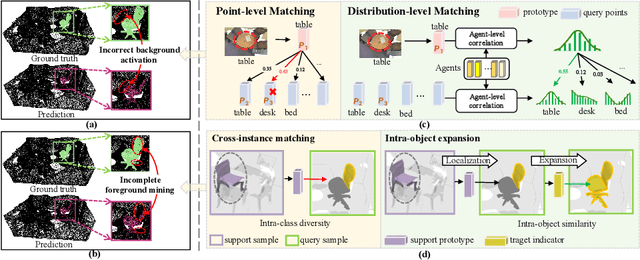
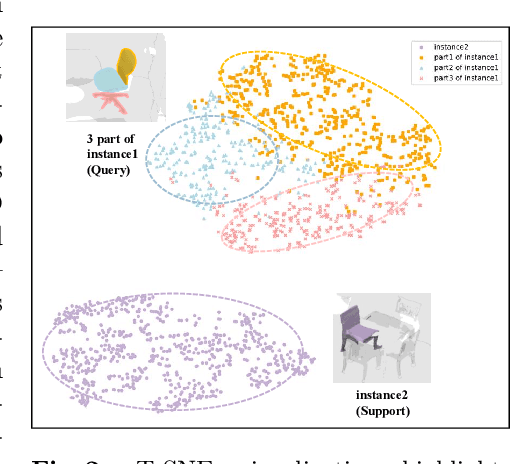

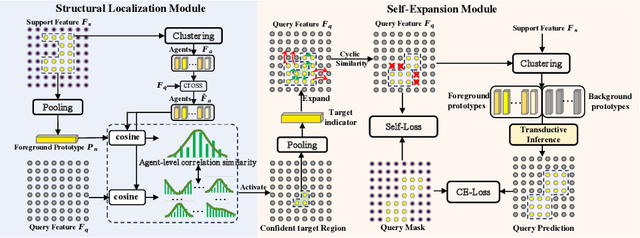
Abstract:Point cloud few-shot semantic segmentation (PC-FSS) aims to segment targets of novel categories in a given query point cloud with only a few annotated support samples. The current top-performing prototypical learning methods employ prototypes originating from support samples to direct the classification of query points. However, the inherent fragility of point-level matching and the prevalent intra-class diversity pose great challenges to this cross-instance matching paradigm, leading to erroneous background activations or incomplete target excavation. In this work, we propose a simple yet effective framework in the spirit of Decoupled Localization and Expansion (DLE). The proposed DLE, including a structural localization module (SLM) and a self-expansion module (SEM), enjoys several merits. First, structural information is injected into the matching process through the agent-level correlation in SLM, and the confident target region can thus be precisely located. Second, more reliable intra-object similarity is harnessed in SEM to derive the complete target, and the conservative expansion strategy is introduced to reasonably constrain the expansion. Extensive experiments on two challenging benchmarks under different settings demonstrate that DLE outperforms previous state-of-the-art approaches by large margins.
The Ninth NTIRE 2024 Efficient Super-Resolution Challenge Report
Apr 16, 2024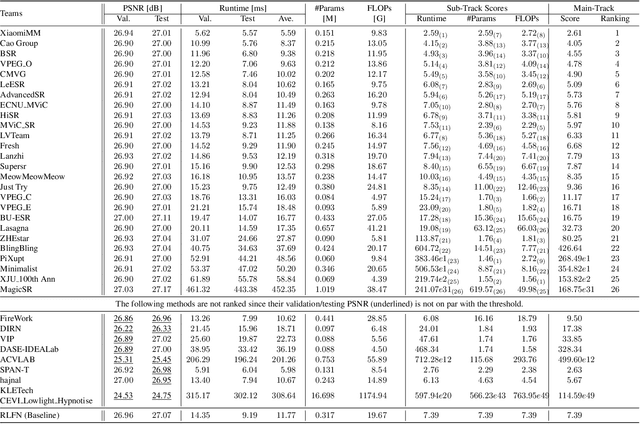
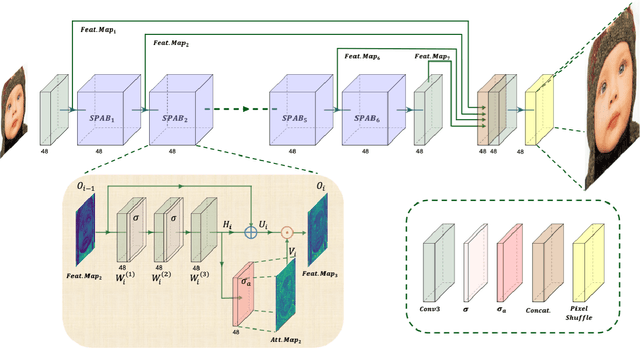


Abstract:This paper provides a comprehensive review of the NTIRE 2024 challenge, focusing on efficient single-image super-resolution (ESR) solutions and their outcomes. The task of this challenge is to super-resolve an input image with a magnification factor of x4 based on pairs of low and corresponding high-resolution images. The primary objective is to develop networks that optimize various aspects such as runtime, parameters, and FLOPs, while still maintaining a peak signal-to-noise ratio (PSNR) of approximately 26.90 dB on the DIV2K_LSDIR_valid dataset and 26.99 dB on the DIV2K_LSDIR_test dataset. In addition, this challenge has 4 tracks including the main track (overall performance), sub-track 1 (runtime), sub-track 2 (FLOPs), and sub-track 3 (parameters). In the main track, all three metrics (ie runtime, FLOPs, and parameter count) were considered. The ranking of the main track is calculated based on a weighted sum-up of the scores of all other sub-tracks. In sub-track 1, the practical runtime performance of the submissions was evaluated, and the corresponding score was used to determine the ranking. In sub-track 2, the number of FLOPs was considered. The score calculated based on the corresponding FLOPs was used to determine the ranking. In sub-track 3, the number of parameters was considered. The score calculated based on the corresponding parameters was used to determine the ranking. RLFN is set as the baseline for efficiency measurement. The challenge had 262 registered participants, and 34 teams made valid submissions. They gauge the state-of-the-art in efficient single-image super-resolution. To facilitate the reproducibility of the challenge and enable other researchers to build upon these findings, the code and the pre-trained model of validated solutions are made publicly available at https://github.com/Amazingren/NTIRE2024_ESR/.
The Multi-modality Cell Segmentation Challenge: Towards Universal Solutions
Aug 10, 2023Abstract:Cell segmentation is a critical step for quantitative single-cell analysis in microscopy images. Existing cell segmentation methods are often tailored to specific modalities or require manual interventions to specify hyperparameters in different experimental settings. Here, we present a multi-modality cell segmentation benchmark, comprising over 1500 labeled images derived from more than 50 diverse biological experiments. The top participants developed a Transformer-based deep-learning algorithm that not only exceeds existing methods, but can also be applied to diverse microscopy images across imaging platforms and tissue types without manual parameter adjustments. This benchmark and the improved algorithm offer promising avenues for more accurate and versatile cell analysis in microscopy imaging.
 Add to Chrome
Add to Chrome Add to Firefox
Add to Firefox Add to Edge
Add to Edge